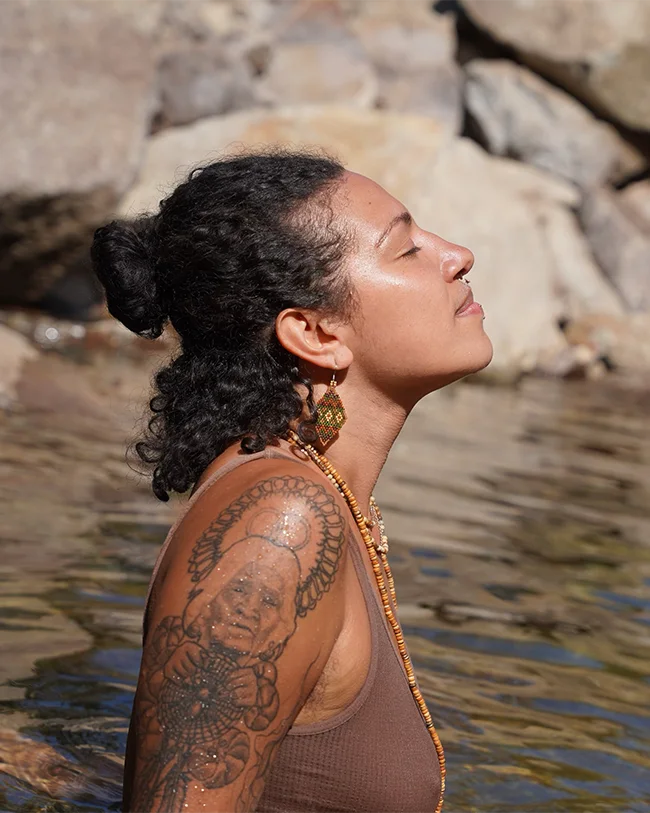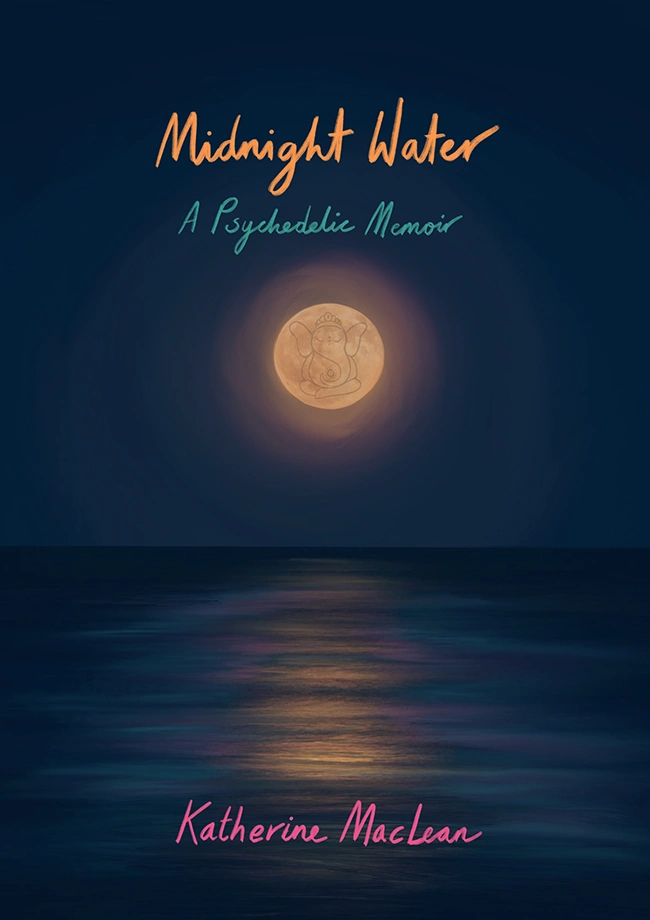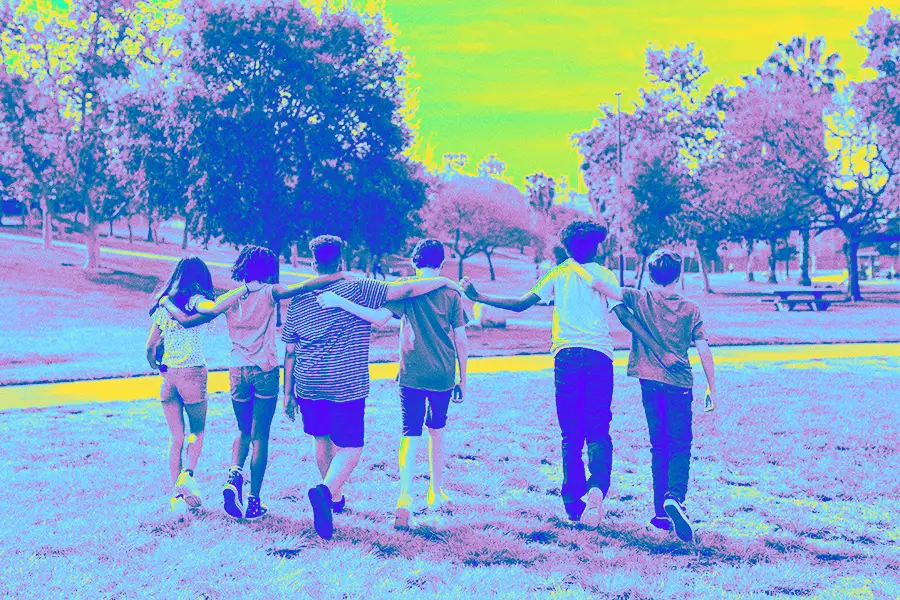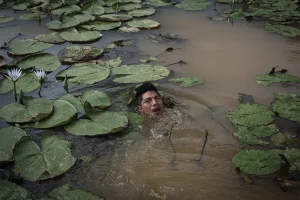That sick, tight feeling twisted Avery’s* guts: anxiety and dread, disbelonging in their skin, pooling in their stomach and manifesting in their slender frame. An hour into the mushroom trip, the 16-year-old couldn’t stop vomiting as discomfort rushed to the surface. Clutching her stomach [Avery uses she/they pronouns], she laid her head in her mother’s lap.
Lynn* stroked her child’s hair, seeing them as a six-year-old again in the psilocybin glow. She ached to take away Avery’s pain, but knew it was part of the process; after all, they had chosen to have this coming-of-age ceremony. It was facilitated by Mikaela de la Myco, a family friend and medicine woman. Avery had been struggling to eat and was malnourished; Lynn longed to take their pain away. Suddenly, Lynn had a vision. “I saw this umbilical cord, and I realized I was the one who had to cut it,” she says. “I had to release her.”
Now Lynn doubled over, sobbing, realizing she couldn’t be responsible for her family’s happiness and healing. De la Myco watched quietly, marveling at the shift, as Avery rose and put their hand on their mother’s back, then took her head into their own lap, comforting her. Mother and child then fell back with palms pressed together in “a moment of deep connection,” Lynn recalls, saying, “‘I can’t tell where your hand ends and mine begins.” Suddenly, Avery said, the pain in their stomach was gone.
In the process, Avery later told de la Myco, they learned they were deserving of their own love. For Lynn, “it was a journey about letting go.”
In the Global North, the concept of giving psychedelics to kids strikes fear into the hearts of even the most liberal proponents. Yet mushrooms and plant medicine are part of daily life for people of all ages, from babies to elders, in global cultures with roots that stretch back to the dawn of humanity. Today, a growing number are discovering that psychedelic literacy and experience can benefit the whole family, especially youth.

“The public wants to hear that we’re all dosing our kids,” de la Myco says. “What’s really happening is that they’re getting the downriver benefits of having family members with a psychedelic life…being welcomed into the community and getting access to wisdom by proxy…until they’re ready to make their own choices.”
How to Grow Shrooms Bundle
Take Both of Our Courses and Save $90!
According to a 2016 survey from the CDC, many US youth are already on drugs: Nearly 70 percent of six- to 11-year-olds and 62 percent of teens diagnosed with ADHD take prescription stimulants, which are commonly used to treat symptoms. Most also consume two to three times the daily recommended amount of added sugar, which many health experts consider the most dangerous drug and some say should be treated like a controlled substance.
Classic psychedelics, by contrast, are among the safest psychoactive substances, with mushrooms bearing a low potential risk, according to studies looking at large doses in healthy adults. They’ve also been used in spiritual traditions across the African continent for millennia, says London-based educator, event organizer, and mycologist Darren Le Baron, embedded at every stage of life, from before birth to after death, in societies such as the Khoisan, a rainforest hunter-gatherer people of Sub-Saharan Africa and by generations of communities across Mesoamerica.
READ: More Parents Take Psychedelics Than You Think

In these cultures, “family members actually invoke the child through the [entheogenic] experience,” Le Baron says, describing ceremonies where potential parents call children’s souls to Earth and psychoactive fungi and plants are taken as the child is conceived. They’re part of supportive botanical mixtures given to pregnant mothers; used for pain relief during childbirth; and are among the child’s first foods, passed along through breast milk from microdosing mothers before being introduced more formally to children through rituals during puberty.
But these cultures don’t categorize and divide things the same ways we do, Le Baron notes. Psychedelics aren’t considered something lurid, or even all that special; they’re simply part of the panoply of plants that can heal and harm you when living off the land. “All these groups have a relationship with different plant technologies, and they introduce them as a child,” Le Baron says. “Everyone learns how to heal themselves, [because] your healing potential is your birthright.”
There’s also no such stage as “adolescence” in these societies, Le Baron says: people go from child to adult overnight, with eight- to 12-year-olds now considered equal to those in their 40s. They’re walked across the threshold in rites of passage, guided by elders and ancestors who have carried the traditions for centuries.
In traditional cultures around the world, including South America, where he has done extensive research, and dating back millennia, “Young people are taken from the home and made to pass a difficult experience…where they need to rely on their own strength and resources to get through,” said Jeronimo Mazasarra, an ayahuasca community activist who works for the International Center for Ethnobotanical Education, Research, and Service (ICEERS), at the Breaking Convention conference in May 2023. “This seems to provoke growth and maturation, and the person returns transformed.” It involves altered states: solitude, surviving extreme conditions, psychedelics, or all of the above. Importantly, they’re received back into the community as a new person, with new roles, responsibilities, and social regard. In comparison, says Le Baron, “Most Western adults are still children. That’s why we’re doing all this inner-child work.”
Some families, communities, and organizations are bringing back coming-of-age rituals. Mazasarra describes a US wilderness retreat where kids learn survival skills and are then left on their own (with adults camping nearby for support), even giving themselves a new name. While they’re gone, their parents are trained in how to receive them: not with “welcome back,” but rather, “we can’t wait to meet you.”
There are also people like Avery and Lynn who work with facilitators to design their own rituals. Lynn and her husband are part of a community de la Myco has created where families and individuals come together for ceremonies and social events in a safe, judgment-free setting. Avery was received back into an environment that acknowledged their transformation, and has access to a culture of elders if she needs further information and support.
There may not be neuroimaging studies of children who have done psychedelics, but the persistence of cultures like the Khoisan is proof that there’s validity to these traditions, says Le Baron. Their lineage stretches back 22,000 years, when they were the largest group of people on earth, making them among the Earth’s first humans.
READ: How To Come Out To Your Kids About Psychedelics
“When people ask me [if] it’s safe to give children psychedelics, I just share that,” he says. “It’s still implemented to this day by people who have been the custodians of these plants for thousands of years…Those are my trials.”
This isn’t just about giving children psychedelics, say Le Baron and de la Myco. It’s about a shift in the family culture, more broadly, and dismantling stereotypes surrounding parents who are having these conversations; those parents aren’t just in cultures removed from capitalist modernity, but in homes and communities from Berkeley to Brixton.
In the media, stories of “moms who microdose” often equate parents who use psychedelics to “wine moms,” seen by some as those who have to check out to deal with their kids. On the contrary, microdosing puts her more in touch with her emotions, enabling her to be more present with her son, de la Myco says. She even used the practice to help her quit drinking after getting pregnant. Others experience similar benefits, as de la Myco has found through networks of like-minded parents and in her professional practice, where she offers support to people seeking entheogenic healing.
E*, a single dad, says he felt like an outcast before finding de la Myco’s community, and now brings his nine-, 12-, and 17-year-old to her gatherings. E plays guitar for ceremonies, and the kids join for the opening and closing circles, spending the rest of the time playing with other kids in a nearby tent or gazing at the stars. E only takes a small dose, checking on the kids periodically. “They get to see how people change and grow from beginning to end, without witnessing the middle portion,” he says.
People often come to ceremonies to heal their childhood trauma, E explains, so that sometimes includes screaming, crying, or vomiting, but he just tells his kids: “We’re here to help them get through it, and there’s no need to be afraid.” Knowing to expect it, they aren’t. If anything, they find what the adults are doing “boring,” he laughs.
But they also know not everyone understands this world, including their mom. E, in a custody battle, gave his kids a choice: keep coming with him and don’t tell her, or stop going. The kids chose to keep going. “I think it shows they feel there’s something there,” he says. “They said they’ve never felt unsafe at all.”
Psychedelic spaces aren’t always necessarily supportive of parents though, says Katherine MacLean, a writer and research scientist who studies psychedelics. With her dad dying of a brain tumor and father-in-law having recently passed, postpartum depression brought her to her lowest point.
How to Grow Shrooms Bundle
Take Both of Our Courses and Save $90!
“I set up a solo MDMA experience to save my own life,” MacLean says. Despite her depth of knowledge, “I was really nervous…making that decision of how to take care of myself in my home, with a drug that’s been labeled as illegal and dangerous, with a baby and a toddler.”
There’s scant information on the subject of parents having psychedelic experiences, even for researchers; MacLean was uncertain of how it might affect her, but the legal risks scared her more than the substance. Parents who use psychedelics safely and responsibly in their personal time are not only stigmatized in public circles—they’re at risk of having their kids taken away. The risk is heightened for people from marginalized backgrounds who already suffer systemic discrimination.
“Thank God I did it; it turned my life around,” MacLean says, detailed in her book Midnight Water. “But it’s a huge risk…The decriminalization laws have to protect mothers from their children being taken…and we have to change the whole judgment around it making you an unsafe parent. I recognize my privilege to speak out about it.”
Neuroscientist Dr. Carl Hart calls the War on Drugs: “a war on pregnant women.” In his book Drug Use for Grown-Ups, he writes that most studies reported in the press are misleading, citing “changes” in brains and behavior with no baseline or follow-ups established and claiming cognitive impairments when users’ performance varies little from those who abstain.
For many, it takes witnessing a friend or family member’s transformation to begin seeing psychedelic substances as potentially life-saving medicines. After her own experience, MacLean helped her brother through his first psychedelic experience when he experienced mental health challenges, while E’s mother, who long protested his cannabis use, ultimately sat with him in her own ceremony.
“I want to believe there’s a place for parents, in consultation with elders and other community members, to help a child decide when they are ready to have a certain experience. That could be psychedelic, it could be a meditation retreat, it could be a wilderness experience,” MacLean says.
Knowledge is the missing piece, says de la Myco. “My work is creating free and accessible education specifically geared towards parents and the heads of families, so psychedelic literacy can be embodied in the family unit.”
Akua Ofosuhene, a London-based dressmaker and event organizer, walked this exact path, experiencing the transformation of her family unit as she embarked on a journey with plant medicines and, then, her son followed. She had watched her son slip away at age 14, when he joined a gang. “To be able to deal with it, I realized that I needed to become a different kind of mother,” she says. Already suffering from PTSD, “psychotherapy was too slow, and I didn’t want to take antidepressants, because I needed to be more than somebody who wasn’t depressed. I needed to have better ideas.”
Exploring alternative healing modalities, Ofosuhene discovered EFT (Emotionally Focused Therapy; tapping acupressure points to process difficult feelings), self-inquiry practices, and resources for helping traumatized parents and kids reattach. But discovering iboga, a psychedelic shrub native to Central Africa, she says, “felt like coming home.” She realized psychedelics could help her son do the same.
Ofosuhene found a roadmap in R. Coleman’s Psychedelic Psychotherapy: one session with MDMA, followed by another with mushrooms. Over the next three years, as the positive changes manifested in her own life and personality, she began talking on the phone with her son, now 17, and eventually, he agreed to having his own medicine journey. He was comfortable with psilocybin, but had considered MDMA a drug as dangerous as the crack and heroin he’d been selling. It wasn’t until he was pouring his heart out to his mother about wanting out of his life that his perspective shifted.
“Within 24 hours, my son was completely out of that world. From that moment on, I realized I had found something profoundly amazing,” Ofosuhene says of her son’s first psychedelic experience. “Everyone could see it was the only thing that worked.”
Of the group of friends who were groomed at the same time as her son, he’s the only one who got out, Ofosuhene says. Two years later, her son has continued working with psilocybin, slowly recovering from PTSD and rebuilding his confidence; he passed his exams and is helping Ofosuhene run a jewelry business. Her sister and elderly mother have found relief for physical and emotional symptoms through microdosing, and Ofosuhene facilitates ceremonies for people coming out of coercive situations, from gangs and cults to abusive relationships.
If parents come to her wanting to treat their childrens’ issues with psychedelics, she tells them, “I won’t work with your kid, I’ll work with you,” Ofosuhene says. “The parent is the number-one person who ultimately knows how to reach their child. We also do things that fuck our kids up. Parents have to do their own healing first.”
In some communities, people bring babies to ceremonies, and learn more from them than the other way around, says de la Myco. In a Clubhouse forum she hosted in May of 2023, one participant described bringing her one-year-old to a peyote ritual where the whole family healed from his traumatic birth. “I’ve seen really little kids trigger big healing experiences for themselves, the group, and their parents just simply by existing,” de la Myco says.
In Avery’s psychedelic experience, they also felt the intimate tie between their healing and their mom’s healing. They realized that their stomach problems arose from the cord still connecting them to their mother, who saw the same patterns she dealt with as a teen replicating in her child’s life. “In a perfect world, we’d all be healed before having kids, but at some point you have to break the cycle,” Lynn says. “I attribute that to psychedelics and plant medicine, and us finding a community where there is a search for healing. I’m grateful I’ve had the opportunity to grow alongside my kids.”
Avery’s ceremony showed them that their stomach and spirit were devoid of nutrients and needed to be nourished while empowering them to heal generational wounds. “Avery has a lot more power to tell me straightforward, ‘this is how you hurt me.’ It isn’t always easy to hear, but I really appreciate the way you communicate and how much strength you have,” Lynn tells her child. “Your honesty helped me to grow as a person and parent.”
Avery still deals with anxiety, but it’s much more manageable, and they say they’re now living and expressing authentically. Now 18, they tell me with a smile: “I’m the person I wanted to be growing up.”
*Names have been changed to protect the source.
Correction: This article originally claimed: “Nearly 70 percent of six- to 11-year-olds and 64 percent of teens are taking prescription stimulants for ADHD.” This statement has been corrected to: “Nearly 70 percent of six- to 11-year-olds and 62 percent of teens diagnosed with ADHD take prescription stimulants.”

DoubleBlind is a trusted resource for news, evidence-based education, and reporting on psychedelics. We work with leading medical professionals, scientific researchers, journalists, mycologists, indigenous stewards, and cultural pioneers. Read about our editorial policy and fact-checking process here.

DoubleBlind Magazine does not encourage or condone any illegal activities, including but not limited to the use of illegal substances. We do not provide mental health, clinical, or medical services. We are not a substitute for medical, psychological, or psychiatric diagnosis, treatment, or advice. If you are in a crisis or if you or any other person may be in danger or experiencing a mental health emergency, immediately call 911 or your local emergency resources. If you are considering suicide, please call 988 to connect with the National Suicide Prevention Lifeline.



